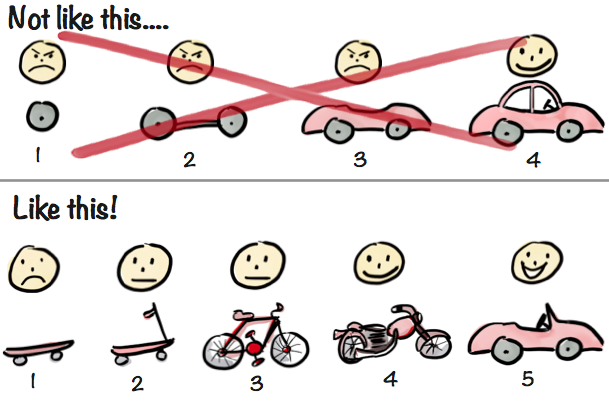What’s the biggest barrier for your next car to become “Smarter”? There are many for sure & your guess is as good as my 😏. But I do know one thing for sure: no one is going to success in this digital transformation by doing the business as usual. To be faire, car makers had a good ride from adding AM radio & more “features” to car infotainment systems since 30s. Only this time, the new game is very different. Anyway for anyone wants to move faster, there might be a few pivots to make the journey better.

Any Crystal Ball, That Works?
The bad news first, there is no such thing. Do let me know if you have one working at least 51% of the times 😉. So what could be the 2nd best? I would try to reduce the cycle time between feedback to change. So the risk exposure is chunked and more time to adapt surprises. Sure, it’s easier said than done. But let’s try to explore how a bit further.
Shorten Product D2D Cycles
The math is simple: Risk of Uncertainty = Impact of Changes / Speed to Adapt. In the old “feature” infotainment world with matured HW innovations, changes were minimized & everyone’s best guesses were a pretty good proxy. Therefore it’s OK to take 2–3 years to develop to ship a new car & its infotainment system. Furthermore everyone play by the same rules. To the new “smart” infotainment world, changes are inevitable & accelerating. Whoever can preempt or response quicker may win. To achieve that, you need a much shorter product development to deployment cycle.

To some extent, it’s how car infotainment systems were built for a long time. But staying on the same course will not make them any smarter 🎓. Take an inspiration from Steve Jobs’ the Lost Interview in 1995: when a product is only changed once in a decade e.g. Pepsi, the sales & marketing people lead product directions. Which can happen in tech too. And when it does, people forget what it means to make great products.
One more example even Intel’s CPU business has been shaking by AMD CPU “substitutes” for imminent terms, and Apple M1 SoC “alternatives” for a longer run. Not to mentioned, Intel had tried & retreated many key verticals, e.g. mobile, wearable, IoT, automotive… On Feb. 15, Intel will have a tech leader Pat Gelsinger as the new CEO. Maybe this time, it’ll be different.

Grow A Happy User Base
Any prosper app/digital service ecosystem has one thing in common: growths of devices, users & apps feed in each other as a virtuous cycle. if playing to such games, car makers need to acquire new users and also retain existing users by keeping them entertained.
Today, most car makers ship a model year & move on. Consequently even within an car maker, its user base are fragmented and UX is outdated by model years & brands. Especially, people do keep driving a car for 10+ years. So car makers are missing out great opportunities to aggregate their user base to provide new digital experience at scale. Sure there were good reasons on why car makers work this way. But a successful disruptor normally does not even care “to play by the rule”. For examples, Tesla even offers free computer upgrade to its Full Self-Driving users. Whereas Apple still upgrades 5 years old iPhones. You wonder why 🤔.

Software-Defined Experience
For a device to be “smart”, it can “learn” new skills. The “easiest” way is to shift functionalities from HW to SW implementation. So functionalities can be added & UX can be upgraded without changing any bit of HW. Beside feature phone vs smartphone, take another older analogy: typewriters improve writhers’ productivity well, but its functionalities are fixed. Whereas for a PC to help your other tasks, you just need another application. Soon there could be a funny car sales pitch: “This car can load 256 GB more apps & it won’t even be 1g heavier. Jack, it’s so magical.” 🤣.
A car infotainment system can be smart if it can run new applications. But it’s not just the jobs of application developers. The whole car infotainment SW are the playing field for continuous innovation. This is going to be fun because for HW, the difference between the best to ok usually less 3x. Whereas the SW dynamic range can be 50 to 1 or even 100 to 1 as Jobs explained in the 1995 interview. But how specifically?

Put A New Smile On Driver’s Face
What if you decouple the SW development to deployment from the HW? A few things may help you to get ahead at least:
- Shorten the SW D2D cycle significantly to deliver/adapt what users really love.
- Reach more users with the same SW in a way maximizing of economies of scale.
- Deliver new functionalities & improve digital experience continuously to add value without adding weight.
This won’t be easy because complexity is an exponential function of SW flexibility. But when it’s done right, the sky’s the limit to put more new smiles on users’ faces 😇. Which could help your product 10x better than others, and it’ll a long time for others to catch up. Want to know how exactly? Kocienda’s Creative Selection is not just a good read, but also a great source of inspirations loaded with real world experiences.
Full Disclosure
The opinions stated here are my own, not those of my company. They are most extrapolations from the news. I don’t have insider knowledge of those companies, nor an EV expert.
